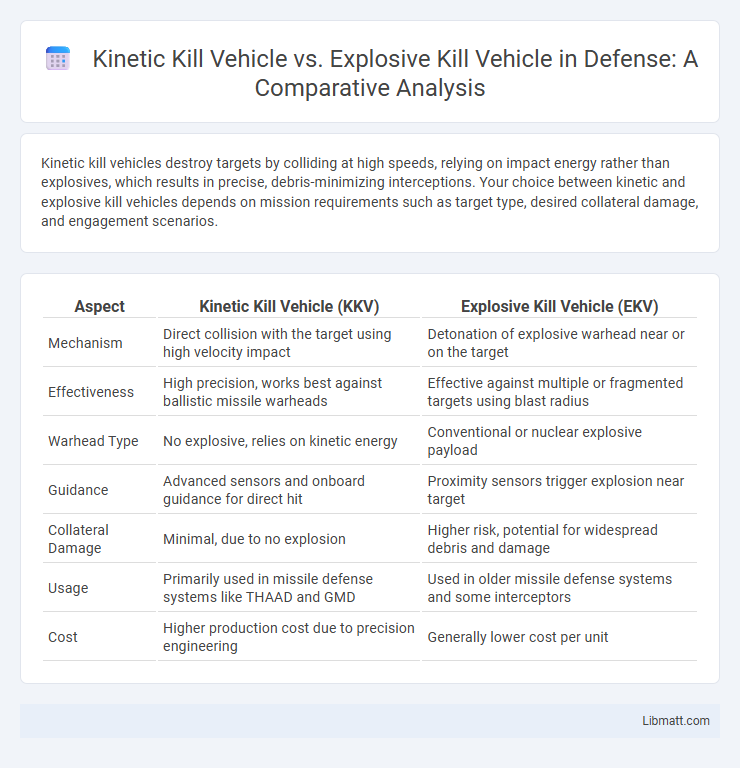Kinetic kill vehicles destroy targets by colliding at high speeds, relying on impact energy rather than explosives, which results in precise, debris-minimizing interceptions. Your choice between kinetic and explosive kill vehicles depends on mission requirements such as target type, desired collateral damage, and engagement scenarios.
Table of Comparison
| Aspect | Kinetic Kill Vehicle (KKV) | Explosive Kill Vehicle (EKV) |
|---|---|---|
| Mechanism | Direct collision with the target using high velocity impact | Detonation of explosive warhead near or on the target |
| Effectiveness | High precision, works best against ballistic missile warheads | Effective against multiple or fragmented targets using blast radius |
| Warhead Type | No explosive, relies on kinetic energy | Conventional or nuclear explosive payload |
| Guidance | Advanced sensors and onboard guidance for direct hit | Proximity sensors trigger explosion near target |
| Collateral Damage | Minimal, due to no explosion | Higher risk, potential for widespread debris and damage |
| Usage | Primarily used in missile defense systems like THAAD and GMD | Used in older missile defense systems and some interceptors |
| Cost | Higher production cost due to precision engineering | Generally lower cost per unit |
Introduction to Kill Vehicles: Kinetic vs Explosive
Kinetic kill vehicles destroy targets through direct impact, relying on high-velocity collision to neutralize threats without explosives. Explosive kill vehicles use warheads to detonate near the target, creating blast effects that destroy or disable it. Your choice depends on mission requirements, with kinetic offering precision and reduced collateral damage while explosive provides a broader area of effect.
Core Principles of Kinetic Kill Technology
Kinetic kill vehicles neutralize targets by relying solely on high-velocity impact energy to destroy incoming threats, eliminating the need for explosives. These systems focus on precision guidance and maneuverability to achieve direct collision with ballistic missiles during their midcourse phase. Your defense strategy benefits from the reduced risk of collateral damage and increased reliability offered by this impact-based technology.
Fundamentals of Explosive Kill Mechanisms
Explosive kill vehicles utilize high-velocity fragmentation and blast effects to incapacitate targets by detonating a warhead near the threat, maximizing damage through shrapnel dispersion and shockwaves. These mechanisms rely on precise proximity sensors and timing to ensure the explosive payload detonates within an effective kill radius. The fundamental advantage lies in their ability to neutralize multiple components of incoming threats, such as warheads and guidance systems, through widespread destructive effects.
Design and Engineering Differences
Kinetic kill vehicles rely on precise guidance systems and aerodynamic designs to achieve direct collision with target missiles, using sheer impact energy for destruction without explosives. Explosive kill vehicles incorporate warheads with high-energy explosives and fragmentation mechanisms designed to detonate near the target, maximizing damage through blast and shrapnel. Engineering differences include the kinetic kill vehicle's emphasis on robust sensor accuracy and impact durability, while explosive kill vehicles prioritize detonation timing and warhead integration.
Target Engagement and Interception Methods
Kinetic kill vehicles neutralize threats through direct collision, relying on high-speed impact energy for target engagement, enabling precise destruction without explosive payloads. Explosive kill vehicles use shaped charges or fragmentation warheads to destroy targets via blast and shrapnel, affecting a broader area and multiple components of the threat system. Interception with kinetic kill vehicles demands exact targeting and guidance systems for hit accuracy, while explosive kill vehicles allow some margin of error by detonation proximity triggering.
Advantages of Kinetic Kill Vehicles
Kinetic kill vehicles provide precise target elimination by using direct impact at high velocity, minimizing collateral damage and reducing the risk of unintended explosions. Their reliance on kinetic energy rather than explosives enhances reliability and safety during intercept missions in missile defense systems, such as THAAD and GMD. This technology enables effective neutralization of incoming ballistic threats without residual explosive hazards or fragmentation risks.
Benefits of Explosive Kill Vehicles
Explosive Kill Vehicles offer enhanced versatility by delivering a blast radius that can neutralize multiple threats or incoming warheads simultaneously, increasing interception success against complex missile attacks. Their fragmentation effect can disable target components beyond direct impact points, improving kill probability in scenarios involving evasive maneuvers or decoys. These vehicles often require less precise targeting compared to Kinetic Kill Vehicles, reducing the demand for extremely high-speed impact accuracy.
Challenges and Limitations of Each Approach
Kinetic kill vehicles face challenges such as requiring extremely precise targeting and high relative velocity to successfully intercept and destroy incoming threats, which can be technologically demanding and costly. Explosive kill vehicles, while capable of damaging multiple fragments of a target, face limitations in terms of controlling the blast radius and avoiding collateral damage, as well as potential failure to neutralize all debris. Both approaches must address issues of guidance accuracy, speed of response, and reliability under varying operational conditions.
Real-World Applications and Deployment Scenarios
Kinetic kill vehicles (KKVs) are widely deployed in missile defense systems to physically collide with incoming ballistic threats, providing a precise, debris-minimizing solution ideal for high-value targets such as intercontinental ballistic missiles (ICBMs). Explosive kill vehicles use proximity-fused warheads to detonate near the target, creating a blast radius effective against multiple or smaller objects, making them suitable for layered defense in theater missile defense. Your choice between KKV and explosive kill vehicle depends on mission parameters, threat characteristics, and the engagement environment.
Future Trends in Kill Vehicle Development
Future trends in kill vehicle development emphasize enhanced precision and adaptability, with kinetic kill vehicles evolving to incorporate advanced guidance systems and improved hit-to-kill technology for greater accuracy against maneuvering targets. Explosive kill vehicles are increasingly integrating smart fuzing and controlled fragmentation to maximize target neutralization while minimizing collateral damage. Your defense capabilities will benefit from these innovations, as next-generation kill vehicles focus on faster response times and multi-spectral sensor fusion for comprehensive threat engagement.
kinetic kill vehicle vs explosive kill vehicle Infographic

 libmatt.com
libmatt.com